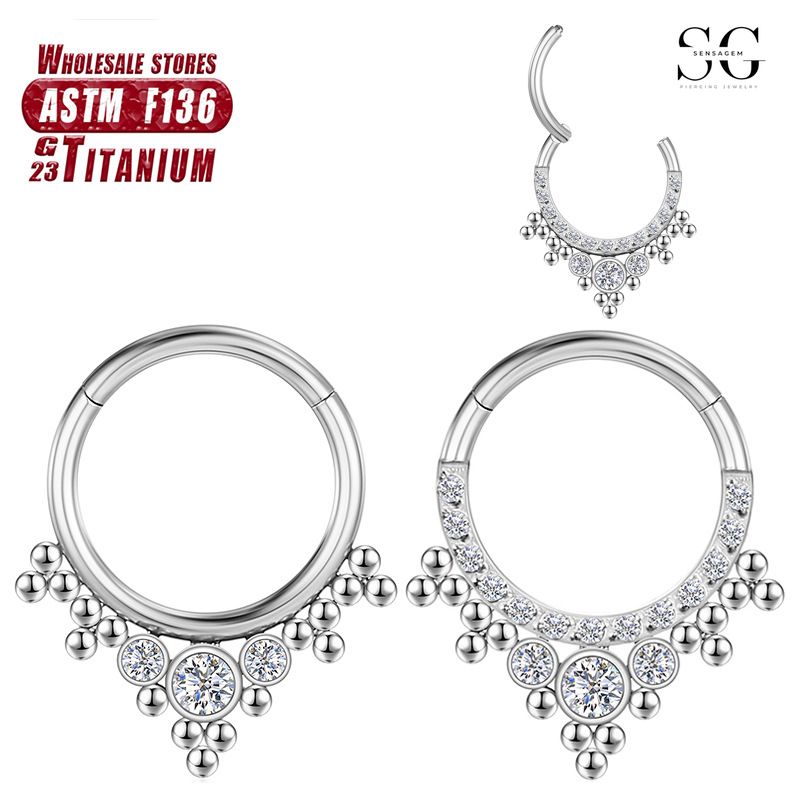Introduction
Choosing the best piercing jewelry material is vital not only for style but also for comfort and safety. With so many options available, from traditional metals to modern eco-friendly alternatives, it can be challenging to decide which material is right for you. This season, trends highlight sustainability, hypoallergenic options, and innovative designs, making it the perfect time to explore your choices. In this guide, we’ll break down the best piercing jewelry materials, their benefits, and why they matter.
1. Emerging Trends in Piercing Jewelry Materials
The body piercing industry is undergoing a transformation, with an increased focus on eco-friendly and sustainable materials. Bioplastics and recycled metals are gaining popularity due to their minimal environmental impact and compatibility with sensitive skin.
In 2023, the global body piercing jewelry market was valued at $59.8 billion and is expected to grow at a CAGR of 6.6% through 2030. For more details, visit this market report.
2. Why Material Matters: Safety and Comfort
The material you choose for piercing jewelry directly impacts your skin’s health and healing process. Hypoallergenic materials, such as titanium and bioplastics, are highly recommended for initial piercings, while options like surgical steel offer durability for everyday use.
When selecting the best piercing jewelry material, consider the following factors:
•Allergy Risk: Avoid nickel-containing materials to prevent irritation.
•Durability: Choose corrosion-resistant materials like titanium or surgical steel for long-term use.
•Healing Period: For new piercings, opt for biocompatible materials to reduce infection risks.
3. Sustainable Choices: Eco-Friendly Materials on the Rise
Sustainability has become a significant factor in jewelry manufacturing. Materials like recycled metals そして bioplastics are being adopted by brands to align with consumer values. Recycled metals reduce waste and energy consumption, while bioplastics are biodegradable and vegan-friendly.
For instance, bioplastics are lightweight, 低刺激性, and perfect for those with metal sensitivities. They also provide a vibrant range of colors and flexibility, making them an attractive choice for modern piercings. Learn more about sustainability in piercing jewelry in this insightful article.
4. Popular Metal Types and Their Benefits
Let’s dive deeper into the most popular materials used in piercing jewelry:

サージカルスチール (316L)
A top choice for its durability, corrosion resistance, and affordability. However, it contains small amounts of nickel, so it may not be suitable for those with severe allergies.

Titanium
Known for its hypoallergenic properties, titanium is lightweight and ideal for sensitive skin. It’s often used for implant-grade jewelry.

金 (14k or Higher)
Offers luxury and aesthetic appeal. Ensure it’s nickel-free and solid gold to prevent skin irritation.

Bioplast
A modern option, offering hypoallergenic and flexible features. It’s especially suitable for new piercings.
These materials are widely recommended for their biocompatibility and safety profiles.
5. The Rise of Bioplastics and Recycled Metals
In recent years, bioplastics そして recycled metals have emerged as innovative materials for piercing jewelry. Bioplastics cater to the demand for sustainable, non-metal alternatives, while recycled metals align with eco-conscious values.
Many consumers prefer recycled metals not only for their sustainability but also for their high quality. They retain the same durability as mined metals but with a significantly reduced environmental footprint.
6. Material Safety: What You Need to Know
Safety is crucial when selecting the best piercing jewelry material. Here are some essential guidelines:
•Choose materials certified as implant-grade, such as titanium or surgical steel.
•Avoid materials with nickel or other common allergens.
•For fresh piercings, prioritize materials like bioplast or glass, which minimize irritation and promote healing.
Pro Tip: Always consult with your piercer to ensure your jewelry is made from safe and high-quality materials.
7. Comparing Traditional and Modern Materials
| Material Type | Traditional (金, 銀) | Modern (Titanium, Bioplast) |
|---|---|---|
| Biocompatibility | Variable | High |
| Weight | Heavier | Lighter |
| Allergic Reactions | Possible | Minimal |
| 持続可能性 | Limited | High |
Modern materials like titanium and bioplast outperform traditional materials in safety and sustainability.
8. Seasonal Trends in Piercing Jewelry Materials
Material preferences change with the seasons. For instance:
•Summer: Lightweight and colorful bioplast designs pair perfectly with casual outfits.
•Winter: Minimalist metallic pieces, often adorned with gemstones, are ideal for adding a touch of elegance.
Staying informed about seasonal trends can help you choose jewelry that complements your style throughout the year.
9. What’s Driving Consumer Preferences?
The growing focus on health, sustainability, and individuality is shaping consumer choices. The majority of piercing jewelry buyers are aged 18-24, and they prioritize:
•Hypoallergenic and safe materials.
•Unique, customizable designs.
•Eco-friendly options.
Brands that cater to these preferences are thriving in today’s market.
Conclusion
When it comes to choosing the best piercing jewelry material, safety, style, and sustainability are key factors. From traditional metals like gold and surgical steel to modern options like bioplast and recycled metals, there are plenty of materials to suit every preference and need.
For more insights, check out this detailed guide on market trends and innovative materials. Making informed choices will ensure your piercing jewelry is both stylish and safe!








